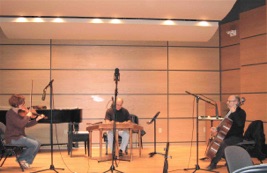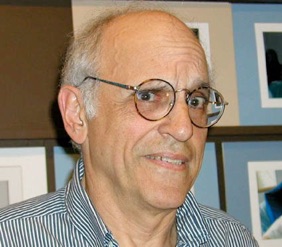Music from the Carpathian Bow


From my twenty-plus years of recording live performances--mostly classical, chamber music with some choral, jazz and big band configurations -- my main interest has always been in the sound obtained in a live space, with total interaction between the performers – not only for the best “live” sound, but also for the best possible on-the-fly musical communication between the performers. Here was a trio with incredible musicians who groove on each other as they perform, and to capture them in a stage setting in a hall was, for me, the most effective way of putting that hot sound onto CD.
We chose a recital space, Fortune Hall in the Cummings Art Center at Connecticut College in New London. Fortune Hall seats about 100, has a lively sound with a polished hardwood stage, and its design lends itself to really hearing performance detail in a small group. I was keenly interested in a space with enough real ambient sound to not require any artificial processing in postproduction. Artificial “wet sound” is the name of the game all too often, details get blurred, and the technique is frequently over-utilized. The trick on the TRAFIK recording session was to get a realistic “live” stereo soundstage, and yet not sacrifice the kind of instrumental pickup and detail achieved in more sterile studio environments.
I’ll get a wee bit technical here, so that anyone with a real interest in the techniques can dig the stuff, and everyone else may either fall asleep or go onto something else!
Having done a good number of surround-sound type recording sessions in large, acoustically reverberant spaces over the last few years, I wanted to apply some of those techniques here. Towards that end, my main capture became one of my all time favorite microphone systems, the British Soundfield ST-250, which was actually designed for ambient surround-type recording, given its tetrahedral internal arrangement of four capsules. A 360 degree spherical capture can be achieved with the Soundfield, and when it is used in conjunction with additional spot and surround microphones, some interesting soundstages result – completely natural, with no artificial processing, and generating a startling lifelike presence in an appropriate surround playback environment.
In this case, we weren’t after the sound of a large cathedral or concert space; rather we wanted just a sense of a live presence but with maximum individual instrumental detail. Normally these two goals are at odds – so that was the challenge!

The Soundfield alone provided a great ambient room capture, and also an excellent ensemble capture. For the individual instrument highlights, I dug into the microphone closet and two Russian OKTAVA MK-67 single cardioid condenser microphones jumped out for close-miking of the violin and the cello. And to get a really fine timbral result for the accordion and tsimbl (cimbalom), I used an Austrian AKG C-422 stereo dual capsule condenser microphone.
This was set up in a close MS pattern pickup through a Wes Dooley (Audio Engineering Associates) MS stereo audio processor to concentrate specifically on sound pickup from the top of the tsimbl, and directly in front of the accordion, when Josh used the latter. Output in L-R stereo directly to two of the the eight tracks on a Tascam digital recorder, via Peter Troisi analog to digital 24 bit converters. Mic preamps were custom Goldhafer Weltmund units for the two OKTAVA mics, with the Soundfield and AKG mics having their own related preamps.
Three full days of recording sessions took care of all the takes. The rest was done in postproduction and actually there were no more than fifteen“edits” – an unusually low number for a production of this kind. Tells you something about these incredible musicians!
No mixing per se was done on site. Direct capture of all channels went to the multitrack recorder, and all balancing was done in postproduction here at the studio listening room using ProTools. Mixing and playback gear consist of a Yamaha ProMix 03-D feeding both the ProTools editor and a set of Hafler amplifiers feeding Apogee Centaurus studio monitors for LR stereo, and rear surround Paradigm monitors. A Genelec self-powered center channel speaker provided critical listening for proper balance.


